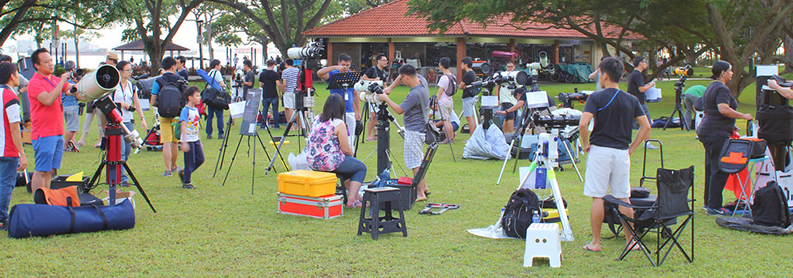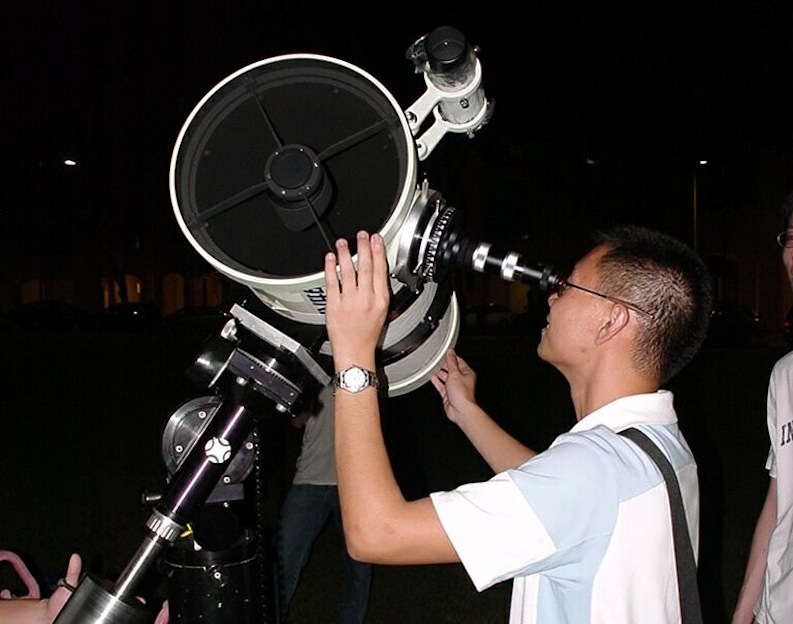Local Astronomy Events

Stargazing activities have become an important and permanent part of the amateur astronomy scene worldwide. Whether they are held at a busy city intersection or at a designated park, these are social gatherings where you can observe to your heart's content, ask astronomy-related questions that have intrigued you for a really long time, try out telescopes, expose the family to the hobby, and most important - to make new friends and have fun!
Organizing a Stargazing Session/Event
Define the astronomy event's purpose clearly. One can save yourself a lot of trouble if you first establish and understand the purpose of the astronomy activity that you are trying to organize. Is the education institution asking you to help them with their domestic astronomy club's activities? Is there a bright comet making the news or an Earth-approaching asteroid zipping by? Are you holding a Jupiter vigil this month for the Jovian's planet best show for the year? Or perhaps you just want to show the heavens to your colleagues or neighbours. Defining your goal will help you set yout expectations and those of your participants and attendees.
Choose the appropriate Date, Day, and Time. In some cases you have little choice. You cannot reschedule a meteor shower or a lunar eclipse. If you are going to show the planets or the Moon, make sure they will be visible. (Incidentally, the best time to view the Moon is at or up to three days before or after the first quarter.) It is really important to make sure that the objects you advertise will be above the horizon during the astronomy event. Do not make any promises you cannot deliver on.
If you have a choice, select a weekend night (Friday or Saturday nights are best!). The public and the astronomers (hosts) are often too tired or too busy (or both) during weekdays. But of the weekdays, Friday night is the most popular. As for weekends, Saturday night is more popular but you could also get a sizable crowd on Sunday nights too.
Our public stargazing sessions in the past last usually no more than 90 minutes or two hours. We encourage the people to arrive before the start time and to stay for the entire activity. These sessions would normally start near the evening twilight to allow the people to arrive white it is still bright and get home sooner.

Choosing the Location. You will want an unobstructed view of the horizon in the direction that is important to your observing plans. You may select a park, or even a parking lot, a side-walk, or any location where you have room for both telescopes and attendees. In any event, in the ideal case, you will want the telescope operators to be able to drive up to the observing site and unload their gear easily. You will also want the attendees to be able to drive up close to, but not into, the viewing area. For the convenience of everyone you should make sure there are restrooms nearby and other relevant admentities.
One should visit a potential observing location during both day and night to make sure it will work out well. If you are going to use private property, you will need the owner's permission and cooperation. If you are going to use a public site, you should contact the related agency in charge. Many shopping centres now require liability insurance before they will allow you to conduct public events within their premises, such as from medical claims resulting from injuries sustained during a stargazing session.
Getting the fellow astronomers' help. Imagine having someone at each telescope providing an exciting visual tour of the universe. The best amateur astronomers are not always the best hosts. Your hosts will be sharing their time with the young and the gold, those who can see well and those who cannot, and those who are knowledgeable about astronomy and those who just think they are. The operators are expected to stay with their telescopes and to find an object in under about a minute. From past events, we have found that amateurs cooperate with each other when the organizer state up front what is expected of them. They would certainly want the stargazing event to be a success too! Be sure you have enough telescopes and operators for your expected number of people so the waiting time at the eyepiece does not get too long.

Advertising the Stargazing Event. If you build it, will they really come? Advertising is an integral part of this whole activity. You can advertise the event far and wide and end up with crowds larger than you can handle, or you can under-advertise it and end up with almost no one during the session.
The internet is a wonderful tool to help with advertising. One could engage in social network avenues, forums, blogs, et cetera. Make sure to give an overview of the event, driving directions to the site, pictures and maps of the location, a list of objects the attendees will hope to see, weather links, and so on. Having it on the internet also gives one the ability to provide last minute updates should anything change. Other advertising tools would be conventional flyers, one-pagers, posters and have them legally distributed through appropriate channels, whether libraries, stores, et cetera. Depending on your connections, you could also go through the radio, TV and the newspapers.
Selecting Objects for Each Telescope. You should meet with the telescope operators prior to each session, and each chooses a few objects on a pre-defined list to show. No one is forced to show anything he or she does not want to. Next, you could hand them out preprinted star maps or URL links for them to display through mobile/tablet devices, highlighting the objects the have chosen, along with a one-line or short paragraphic description of each target (where applicable). The operators will then have something to say about the objects they are showing.
Each telescope will show a particular object for a few minutes before moving on to the next target. Attendees are asked to go from telescope to telescope and look through each one. After about a half dozen trips around the site, they will have seen just about everything on the observing list.
Getting to the Site. Even if you have published directions to the observing site, you might still want to place a few signs nearing the site (with due permission from related authorities). Post the signs at least an hour before the session starts and take them down afterward. Once the attendees arrive, hand out some flyers (they can be star maps, schedules of future similar events, and a list of useful web site links). One can also ask them to dim their cars' headlights and show them the designated parking area and telescope location (especially when held in parks). This important job can be handled by friends or spouses of the astronomers and should continue until well after the session starts.
Kickstarting the Event: Giving the Introduction. Before each practical sky tour, one could give a short talk where resources permit. You would welcome everyone to the event, point out the restrooms, ask them to refrain from using unfiltered torchlights, and give them a few suggestions about using the telescopes. This includes the often-heard advice to not touch the telescopes, to ask for help if they do not see the object, and if they have any further questions, to step aside and let the next person in line view through the telescope while they ask their questions.
You may find that your voice is so soft that people have a hard time hearing you at these events. That is why it might be a great idea to purchase or get your hands on a portable voice amplifier. Halfway through the session you may want to take a short break to point out the constellations. Whether or not you get into the constellations' mythology is up to you, but somehow most people like to know some of most prominent star patterns. Learn beforehand about any bright artificial satellites that are passing by and pause to point them out.

Finishing Touches. In your advertising you may want to make it clear that the session is a "no alcohol, no pets, and no smoking" event. One could have the telescope operators set up their instruments in a big circle so the foot traffic can flow smoothly. Stand in the middle of the circle when you give your introduction and point out the constellations. Ask the telescope operators to bring a small ladder, chair, or stool to help attendees (especially small children) to reach the eyepiece. Have extra red torchlights handy for operators who might need one. If you are not running a telescope, wander among the crowd just to help out others or to answer that inevitable question about UFOs or asteriods-Earth encounter. With a little bit of planning, your next astronomy event can be the best you hae ever hosted! Good luck!
